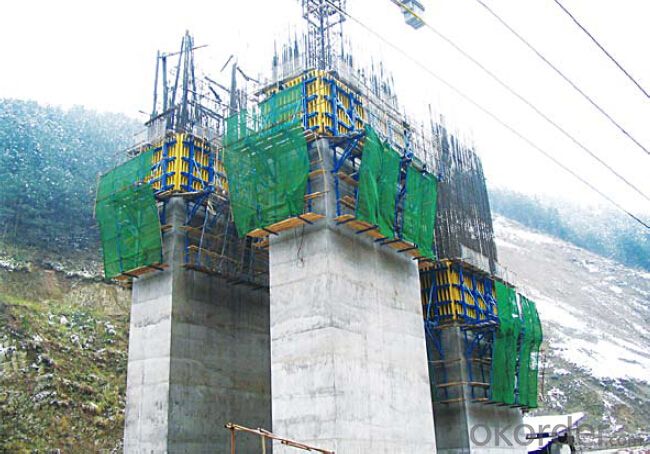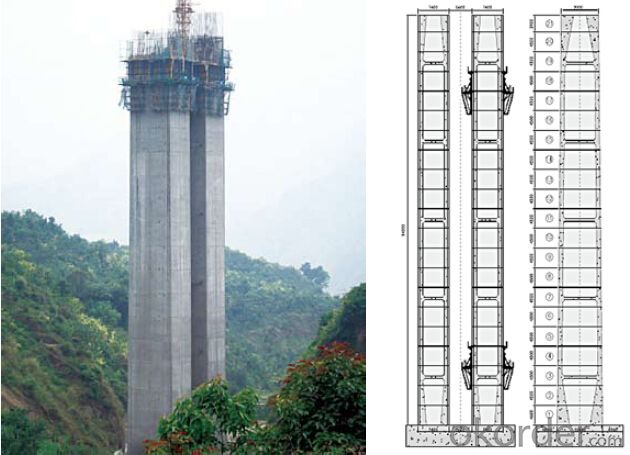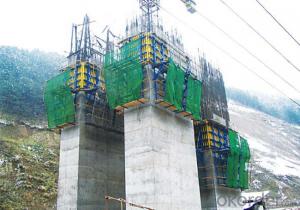Climbing Bracket CB240 & CB210 for formwork and scaffolding system
- Loading Port:
- Tianjin
- Payment Terms:
- TT OR LC
- Min Order Qty:
- 50 m²
- Supply Capability:
- 1000 m²/month
OKorder Service Pledge
OKorder Financial Service
You Might Also Like
Climbing Bracket CB240 & CB210
They are framework brackets for supporting large-area wall formwork.
Typical applications for the CB240&CB210 are pier and column/shear wall/core walll/ in the
building.
CB210 has smaller size than CB240, it will be cost effective in some condition.
Characteristics:
◆ High bearing capacity
The high loading capacity of the brackets allow very large scaffold units. This saves the number
anchor points required as well as reducing climbing times.
◆ Simple moving procedure by crane
Through the strong connection of formwork together with the climbing scaffold, both can be moved
as a single climbing unit by crane. Thus valuable time-savings can be achieved.
◆ Fast striking process without a crane
With the retrusive set, large formwork elements can also be retracted quickly and a minimum of
effort.
◆ Safe with work platform
The platforms have assembled firmly with bracket and will be climbing together, without scaffolding
but can work safely in spite of your high location.
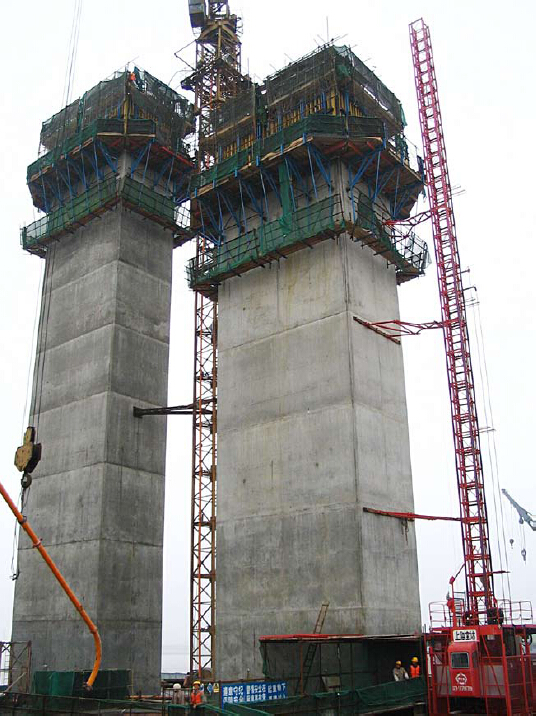
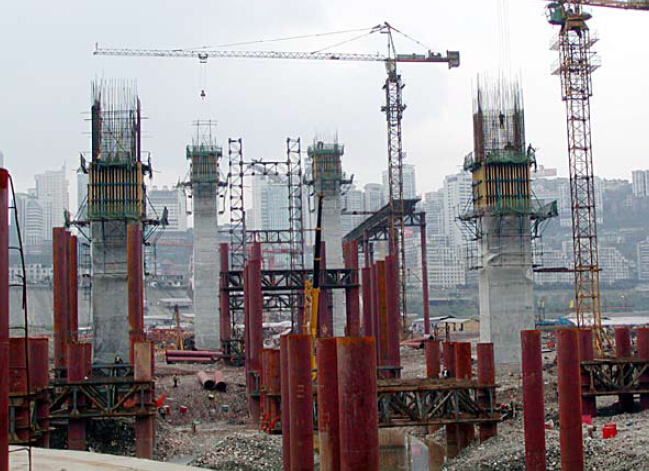
- Q: Can steel formwork be used in corrosive environments?
- Yes, steel formwork can be used in corrosive environments. Steel is known for its durability and strength, making it a suitable choice for construction applications even in corrosive environments. However, in order to ensure its long-term performance, certain precautions need to be taken. One common method is to apply protective coatings such as epoxy or zinc to the steel formwork. These coatings act as a barrier between the steel and corrosive elements, preventing direct contact and reducing the risk of corrosion. Another approach is to use stainless steel formwork, which is inherently resistant to corrosion due to its high chromium content. Regular maintenance and inspection are also necessary to identify any signs of corrosion early on and take appropriate measures to address them. This may involve cleaning the formwork, repairing damaged coatings, or replacing sections that are severely affected by corrosion. Overall, with proper protective measures and maintenance, steel formwork can withstand corrosive environments and provide a reliable and durable solution for construction projects.
- Q: How does steel formwork affect the overall energy efficiency of a structure?
- Steel formwork can significantly improve the overall energy efficiency of a structure. It provides a durable and reusable framework for concrete pouring, reducing material waste and construction time. The precise fit of steel formwork minimizes the need for additional insulation, resulting in better thermal performance and reduced energy consumption for heating and cooling. Additionally, its strength and stability allow for the construction of thinner walls and slabs, maximizing the usable space and minimizing the amount of materials required. Thus, steel formwork positively impacts the energy efficiency of a structure by reducing energy consumption and promoting sustainable construction practices.
- Q: How does steel formwork impact the overall energy efficiency of a structure?
- The overall energy efficiency of a structure can be significantly affected by the use of steel formwork. Firstly, the durability of steel formwork allows for repeated use, reducing the need for new materials for each construction project. This helps to decrease the energy consumed in manufacturing and transporting formwork materials. Furthermore, steel formwork is renowned for its excellent thermal conductivity, enabling efficient heat transfer. This is especially important in structures prioritizing energy efficiency, like residential or commercial buildings. Efficient heat transfer helps to maintain a comfortable indoor temperature, minimizing the need for excessive heating or cooling and thus reducing energy consumption. Additionally, steel formwork can contribute to the overall insulation of a structure. By combining insulating materials with steel formwork, a building's thermal performance can be greatly improved. This insulation prevents heat loss during colder months and heat gain during warmer months, reducing the reliance on artificial heating and cooling systems. Consequently, energy consumption is decreased, resulting in improved energy efficiency. Moreover, steel formwork can be designed to incorporate elements that enhance natural lighting and ventilation in a structure. Allowing more natural light into the building reduces the need for artificial lighting during daylight hours, leading to lower energy consumption. Similarly, promoting natural ventilation through steel formwork decreases the necessity for mechanical ventilation systems, further contributing to energy efficiency. Lastly, the strength and stability of steel formwork enable the construction of innovative and energy-efficient structural designs. It allows for the utilization of larger open spaces, reducing the need for additional structural components and materials. This not only lowers construction costs but also decreases energy consumption associated with producing and transporting these extra materials. In conclusion, steel formwork positively impacts the energy efficiency of a structure through its durability, thermal conductivity, insulation properties, natural lighting and ventilation features, and its ability to enable innovative structural designs. By reducing energy consumption in various ways, steel formwork contributes to the sustainability and long-term energy efficiency of a building.
- Q: What are the safety considerations when working with steel formwork?
- To ensure the workers' well-being and the project's success, it is important to consider several safety factors when working with steel formwork. The foremost priority is to provide comprehensive training to all workers involved in handling and installing steel formwork. This training should cover safe handling techniques for heavy steel panels and proper assembly and dismantling procedures. Additionally, workers should be educated on the potential risks associated with steel formwork, such as falling objects and pinch points, and how to mitigate these risks. Another crucial safety consideration is the use of appropriate personal protective equipment (PPE). It is necessary to supply workers with and enforce the use of PPE such as hard hats, safety glasses, steel-toed boots, and gloves to safeguard against potential hazards. It is also essential to ensure that the PPE is in good condition and properly fitted for each worker. Maintaining safety on a steel formwork site relies heavily on proper planning and organization. This entails conducting thorough risk assessments, identifying potential hazards, and implementing control measures to minimize risks. Establishing designated walkways and clear access routes is vital to prevent tripping hazards and ensure safe movement around the site. Regular inspections of the steel formwork system are necessary to identify any signs of damage or deterioration. Prompt repair or replacement of any damaged or defective components is crucial to maintain the formwork's structural integrity and safety. Finally, effective communication and coordination among workers are essential for a safe working environment. It is important to establish clear communication channels and procedures to ensure that everyone is informed about potential hazards and can promptly report any safety concerns. By prioritizing training, providing proper PPE, planning and organizing the work site, conducting regular inspections, and promoting effective communication, the safety considerations when working with steel formwork can be effectively addressed, reducing the risk of accidents and injuries.
- Q: How does steel formwork contribute to the fire resistance of the structure?
- Steel formwork, also known as steel molds or frames, significantly contributes to the fire resistance of a structure in several ways. First and foremost, steel is an inherently fire-resistant material. It has a high melting point and does not combust easily, making it an ideal choice for formwork in fire-prone areas. When steel formwork is used in construction, it provides a strong and rigid structure that helps maintain the integrity of the building during a fire. The steel molds hold the concrete in place, preventing it from collapsing or disintegrating when exposed to high temperatures. This structural stability allows firefighters to safely enter the building and extinguish the fire without the fear of sudden structural failure. Moreover, steel formwork can act as a heat sink during a fire. The high thermal conductivity of steel allows it to absorb and dissipate heat quickly, minimizing the spread of fire and reducing the overall temperature within the structure. By absorbing heat, steel formwork helps delay the point at which the concrete begins to spall or crack, thereby maintaining the structural integrity of the building for a longer period. Additionally, steel formwork is often designed with appropriate fire-resistant coatings or insulation materials. These coatings provide an extra layer of protection against the heat, flames, and smoke generated during a fire. They can also help in preventing or slowing down the transfer of heat to the concrete, further enhancing the fire resistance of the structure. Overall, the use of steel formwork in construction significantly contributes to the fire resistance of a building by providing structural stability, acting as a heat sink, and incorporating fire-resistant coatings or insulation materials. By utilizing steel molds, architects and engineers can ensure the safety and durability of the structure, even in the event of a fire.
- Q: Can steel formwork be used for precast concrete balconies?
- Yes, steel formwork can be used for precast concrete balconies. Steel formwork offers durability, strength, and stability, making it a suitable option for constructing precast concrete balconies. It provides a smooth finish to the concrete surface and allows for easy demolding and reusability, increasing efficiency in the construction process.
- Q: How does steel formwork handle different concrete surface repair techniques?
- Steel formwork proves to be a versatile and durable choice for managing various techniques used in concrete surface repair. The primary advantage of steel formwork lies in its ability to withstand the pressures and stresses associated with concrete repairs. When it comes to methods like patching or resurfacing, steel formwork acts as a sturdy and stable framework for containing the concrete mixture. It can bear the weight of the repair materials and the pressure exerted by the concrete during the setting and curing process. This guarantees proper containment of the repair and ensures the achievement of the desired shape and dimensions. Moreover, steel formwork offers flexibility in terms of shape and design. It can be easily customized to meet different repair requirements, whether it involves straight surfaces, curves, or complex geometries. The strength of steel enables the creation of intricate formwork structures capable of handling even the most challenging repair projects. Furthermore, steel formwork exhibits excellent reusability and durability. It can be reused multiple times without significant wear and tear, making it a cost-effective solution for numerous repair projects. This durability ensures the formwork's integrity remains intact throughout the repair process, preventing any potential issues and maintaining the repair's quality. Additionally, steel formwork possesses resistance to moisture and chemicals, commonly present in concrete repairs. This resistance ensures that the formwork remains in good condition, avoiding any corrosion or deterioration when in contact with the repair materials. This becomes particularly crucial for long-term repairs where the formwork may remain in place for an extended period. In conclusion, steel formwork emerges as a dependable and efficient option for managing various concrete surface repair techniques. Its strength, flexibility, reusability, and resistance to moisture and chemicals make it an ideal choice for containing and shaping the repair materials, ultimately leading to successful and durable repairs.
- Q: What are the environmental benefits of using steel formwork?
- Using steel formwork in construction projects offers numerous environmental advantages. To begin with, steel formwork boasts exceptional durability and reusability. Unlike traditional wooden formwork, which is often discarded after a single use, steel formwork can be utilized multiple times. This diminishes the demand for raw materials and decreases the amount of waste generated during construction. Additionally, reusing steel formwork reduces the necessity for frequent manufacturing, thereby lowering energy consumption and greenhouse gas emissions associated with production processes. Moreover, steel formwork delivers a superior quality finish to concrete structures. This eliminates the need for supplementary finishes or coatings, resulting in reduced consumption of materials such as paint or plaster. By opting for steel formwork, construction projects can avoid the usage of potentially harmful chemicals found in these additional finishes, benefiting both the environment and human health. Furthermore, steel formwork exhibits resistance to moisture and weathering, rendering it less susceptible to degradation over time. This leads to longer-lasting structures that require fewer repairs and replacements. The extended lifespan of buildings constructed with steel formwork reduces the environmental impact associated with demolition and reconstruction. Additionally, steel formwork enables precise and accurate construction, minimizing material wastage during the concrete pouring process. This efficiency reduces the amount of excess concrete that needs to be disposed of, thereby minimizing the environmental impact of concrete production and waste management. Lastly, steel formwork can be recycled at the end of its useful life. Steel is one of the most recycled materials globally, boasting a high recycling rate and minimal loss of quality during the process. By recycling steel formwork, the demand for new steel production is reduced, conserving natural resources and diminishing energy consumption and emissions associated with steel manufacturing. In conclusion, the utilization of steel formwork in construction projects brings about numerous environmental benefits, including reduced material waste, lower energy consumption and greenhouse gas emissions, minimized use of additional finishes and coatings, extended building lifespan, and the ability to be recycled. These advantages establish steel formwork as a sustainable and eco-friendly choice for construction projects.
- Q: What are the common safety guidelines when working with steel formwork?
- When working with steel formwork, there are several common safety guidelines that should be followed to ensure the well-being of workers and prevent accidents. These guidelines include: 1. Personal Protective Equipment (PPE): All workers should wear appropriate PPE, including safety helmets, safety glasses, gloves, and steel-toed boots. This will protect them from falling objects, cuts, and other potential hazards. 2. Training and Competency: Workers should receive proper training on how to use and handle steel formwork. They should be knowledgeable about the specific tasks they are assigned and have the necessary skills to perform them safely. 3. Inspections: Regular inspections of the steel formwork should be conducted before and during use to ensure that it is in good condition and free from defects. Any damaged or faulty parts should be repaired or replaced immediately. 4. Proper Handling: Steel formwork can be heavy and cumbersome, so it is essential to use proper lifting techniques and mechanical aids when moving or positioning it. Avoiding excessive strain and overexertion can help prevent musculoskeletal injuries. 5. Secure Installation: The formwork should be securely installed and braced to prevent collapse or displacement during concrete pouring. It should be properly aligned and supported to ensure stability throughout the construction process. 6. Fall Protection: Adequate fall protection measures, such as guardrails or safety harnesses, should be in place when working at heights. Additionally, workers should be cautious of slippery surfaces and take necessary precautions to prevent slips, trips, and falls. 7. Hazard Communication: Clear signage and warnings should be posted to alert workers to potential hazards and provide instructions on safety procedures. Communication among workers and proper coordination is also crucial to prevent accidents. 8. Regular Maintenance: Routine maintenance and cleaning of the steel formwork should be performed to remove debris, rust, or other materials that could compromise its integrity. This will help ensure its safety and longevity. By following these common safety guidelines when working with steel formwork, the risk of accidents and injuries can be significantly reduced, creating a safer work environment for all involved.
- Q: Can steel formwork be used for residential tower construction projects?
- Residential tower construction projects can indeed utilize steel formwork. Steel formwork has gained popularity within the construction industry due to its durability and versatility. Its robustness makes it an ideal choice for high-rise structures like residential towers, as it can endure high concrete pressures and deliver a seamless finish. One of the main advantages of steel formwork is its reusability, making it a cost-effective solution for large-scale projects. It is easily assembled and disassembled, enabling efficient construction schedules. Moreover, it provides exceptional support during concrete pouring and setting, ensuring accurate dimensions and alignment. Residential tower projects often require swift construction cycles, and steel formwork facilitates this by allowing for rapid and efficient concrete pouring and formwork removal. Additionally, it reduces reliance on highly skilled labor, as it can be effortlessly handled and manipulated. Nevertheless, it is crucial to consider the specific requirements and design considerations of each residential tower project. Factors such as tower height, load-bearing capacity, and architectural design may influence the suitability of steel formwork. Consulting with a structural engineer or construction professional is highly recommended to determine the most suitable formwork system for a specific residential tower construction project.
Send your message to us
Climbing Bracket CB240 & CB210 for formwork and scaffolding system
- Loading Port:
- Tianjin
- Payment Terms:
- TT OR LC
- Min Order Qty:
- 50 m²
- Supply Capability:
- 1000 m²/month
OKorder Service Pledge
OKorder Financial Service
Similar products
Hot products
Hot Searches


